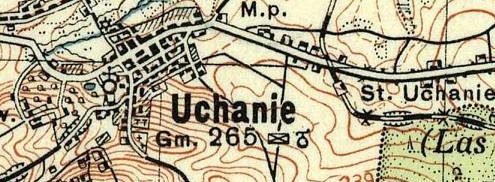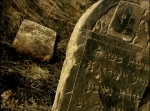| strona główna | cmentarze | warto wiedzieć | księga gości | napisz do nas |
| UCHANIE | |
The first mention of Jewish settlements in Uchanie (in Yiddish: Uchan) dates back to the beginning of the XVII century, but it is almost certain that Jews lived there earlier than that. Unfortunately, the history of the Uchanie Jews was not well documented. We do know that an independent kehilla functioned in Uchanie. Through many years, the majority of the population was Jewish. In 1769, 175 Jews lived in Uchanie. In 1856, out of a total population of 1,342, 786 were Jews. In 1897 there were 1,386 Jews - 70% of the total population. Many Jews left for America during the mass immigration that took place at the turn of the XX century. The census of 1921 recorded only 1,010 people of Jewish descent left in Uchanie. |
|
 |
|
The map of the Uchanie region from 1933, with marked the Jewish cemetery. Source: Archiwum Map Wojskowego Instytutu Geograficznego |
|
With the beginning of the Second World War, Jews faced persecution. They were forced to do labor for the Reich. Their property was confiscated. Jews from neighboring towns (Horodlo being one of them) were deported to Uchanie. In May 1942, 2,025 Jews resided in the town. On June 10, 1942, from the train station in Miaczyn, they were transported to the extermination camp in Sobibor. |
|
 |
|
The Jewish cemetery in Uchanie is located at Podgorze Street. There are several matzevahs on its territory which were rediscovered and brought back here over the last few years. Jacob Finkelstein, who originally comes from Uchanie, in a letter to us describes the cemetery from before WWII: "The cemetery was about 150 square meters. Before the war, a Jew from Uchanie bought more land right next to the cemetery but it never was used for burials. The cemetery used to be full of tombstones. They were neat and cared for. In 1939 when the Germans came, they started to take monuments and made sidewalks out of them. I saw them doing this. By 1942 there were not many tombstones left." The Jewish cemetery in Uchanie was also a place of many executions. Jacob Finkelstein remembers one of them: "On the day after Shavuot (a Jewish holiday usually in May), on a Sunday, 1942, the Gestapo rounded up 43 Jews. Some of them were from Uchanie, some from Horodlo. The Gestapo killed them by shooting - ten in a row, consecutively. My four younger sisters, who did not wear armbands, witnessed everything. I lost my uncle Motl and a great-uncle Shloime. Near the cemetery lived a man named Zdzislaw Masterleczuk. When I was liberated in '44, I met Zdzislaw and he showed me where the Gestapo killed my father in the cemetery. He was buried right near where the entrance to the cemetery is." In 1998 Jacob Finkelstein visited his home shtetl. His daughter, Barbara remembers her visit at the cemetery: "It was untended, grassy plot bordered by wire mesh and an ugly iron gate. It was also slightly higher then street level because space limitations had necessitated burying coffins on top of each other. An elderly survivor named Chaim Ella Leder, who had lost his wife and four children, had erected this graceless fence. Otherwise, no symbols or memorial plaques made note that this was a cemetery. After the war, this Chaim moved in with the Ukrainian woman who helped him survive. One day he received a note from some Polish farmers ordering him to leave Uchan. If he stayed, the note promised, he would be killed. We had no problems entering the cemetery, although there was not much to be seen there. After the war, my father found out (from people living nearby) that his father was killed by Poles and buried in the cemetery. He tried to find some trace of the grave - unsuccessfully. |
|
| We look forward to receiving any information about Uchanie Jews and their cemetery. We are also awaiting more information from people who remember the cemetery from times before World War II.. |
|
The text and pictures are the property of the authors. To utilize this material it is necessary to obtain the written permission from the editor. |
|
| Our thanks to Jacob Finkelstein and Barbara Finkelstein for their precious help | |
| strona główna | cmentarze | warto wiedzieć | księga gości | napisz do nas |
